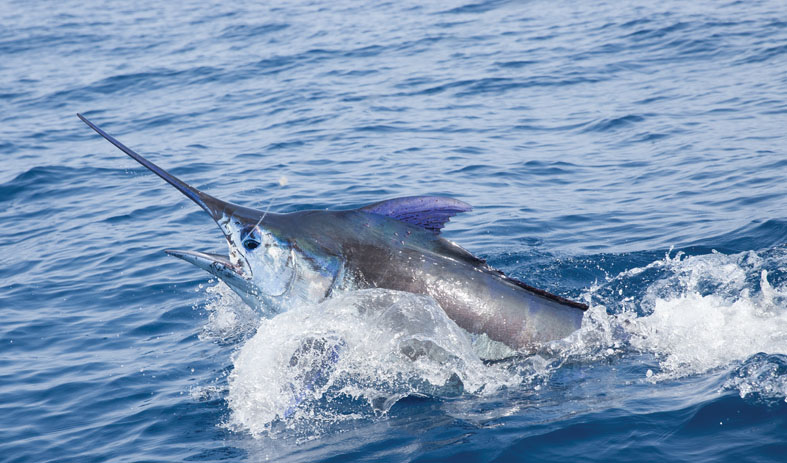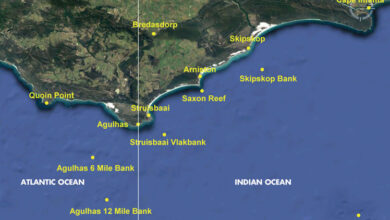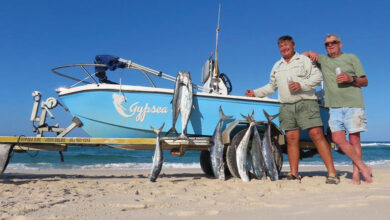SNELL VS CRIMP
What’s the best way to secure circle hooks?
(First published in the May 2021 issue of SKI-BOAT magazine)
By Stuart Simpson
A SIMPLE question asked frequently on deep sea fishing social media groups over the last few months has solicited many different opinions, but boils down to either “snell” or “crimp”. No definite conclusions were reached in the online discussions about which one of these methods is best, simply because there can be no definite answer one way or the other due to the complexity of this style of offshore angling. One also has to take into account the extended array of angling options being used for divergent target species — especially billfish — combined with the diversity of line classes traditionally used.
Stuart Simpson is a Durban prodigy who, after a long stint as a charter captain at Hemingsway Resort at Watamu in Kenya, relocated to the Cape Verde islands where he is one of the top international charter skippers operating in this world renowned marlin “hotspot” on his own boat Nha Cretchéu. He also skippers a sportfisher off Morocco during the white marlin season off this North African country.
Stuart sets out below an incredibly detailed explanation of why and how he uses both snelling and crimping when targeting marlin. He also advises how these strategies can be used in South African waters. …

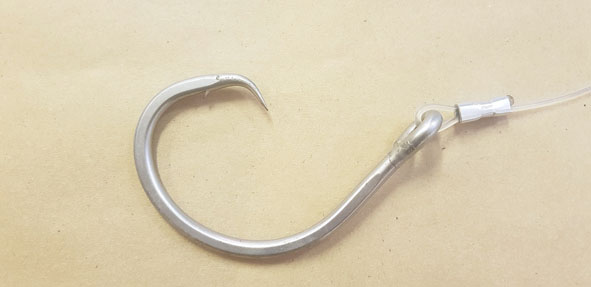
SNELLING AND CRIMPING
To start with, as with any knot or other method of attaching hook to leader, this must be 100% perfect. There’s no such thing as “It looks okay” — okay is not good enough.

SNELLING A CIRCLE HOOK
Whether one is using 50 lb leader or 300 lb leader, the method is well known, but what is important is that the knot tied must be precise — as is shown in the accompanying photographs. In addition, it is essential — absolutely essential — that after completing the snell the leader exits the hook’s eye facing the point/barb of the hook. Not only does this pull the barb of the circle hook into the correct position to ensure a hook-up in the “scissors” of the billfish’s jaw, but it also holds the hook in place throughout the fight.
Viewing the knot tied on a 300 lb leader, the top loop must be tight up against the bend in the hook shank as it forms the eye, never the other way around. Additionally, when pulling up the snell, ensure it is as tight as you can get it on the hook shank before pulling the knot into the position explained above. As indicated on the photograph above, when the snell breaks it will always break in one of two places, hence the importance of the way the knot is finally tied.

CRIMPING A CIRCLE HOOK
Again I must stress the importance of ensuring you create the perfect crimp. In essence, this crimp — or indeed any knot for leader to hook attachment — is the weakest point in your terminal tackle make up, so if it’s not perfect on final inspection, cut it off and recrimp. It’s far better to waste a crimp than lose a big fish.
I personally don’t use chafe protectors when forming the loop before crimping simply because I have never lost a marlin from the leader chaffing through where it’s connected through the hook eye.
The few musts when crimping are as follows:
• The crimp must be the exact correct size for the leader being crimped.
• The heat-formed bubble on the tag end must be firmly pulled up against the crimp before crimping.
• Always place the crimp in the appropriate size slot on the crimping tool so that the crimping takes place while the crimp is positioned side-on.
• Ideally use a table-mounted crimping tool with only one crimp in the centre of the crimp. Don’t double crimp. If you are not satisfied with the first crimp, rather cut off and recrimp.
• The size of the loop through the hook’s eye is extremely important. When crimped, this loop must be reasonably small to ensure that the eye of the big circle hook doesn’t get snagged within the loop.
• Forming the heat bubbles correctly on the end of the tag end is another important aspect of the leader-to-hook make up when crimping. Heat the end of the leader with a lighter until a good-sized mushroom-shaped bubble is formed, then let it cool naturally. Don’t, I repeat don’t, flatten the bubble. When a heat bubble is totally flattened, it reduces the strength of the area where the flattened surface is attached to the leader material.
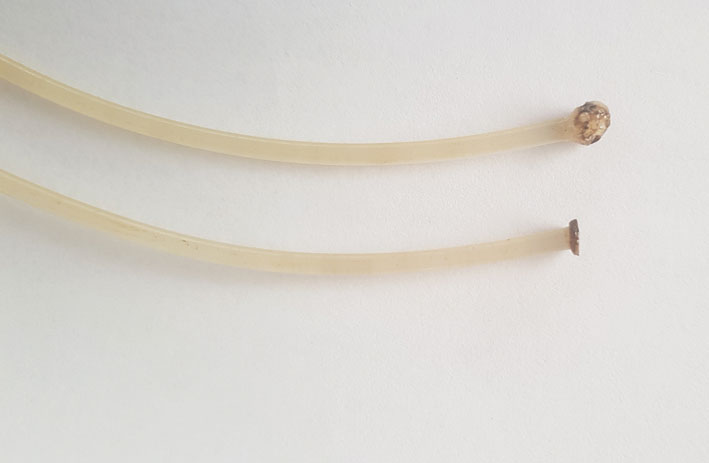
WHICH IS BETTER?
Back to the big question — which is better, crimping or snelling? My view is that they are both excellent methods and both play a role in deep sea angling. However, what is indisputable is that, on a pull-off, the crimp will win every time over the snell.
I maintain that when fishing for marlin, generally crimping, if done correctly, is not only stronger than snelling, but is also excellent for livebaiting, skipping or swimbaits. If that’s the case, why do I use a snell so often? The answer is simply that I use this to my advantage when fishing for marlin off Cape Verde where the vast majority of marlin are released.
In Cape Verde where pitch baiting to marlin is very successful, I use a leader which incorporates a loop-to-loop connection which allows me to have the main leader connected to the rods and the variation of short leaders kept separately, facilitating easy changes. If there is bill-wear evident on the front-end leader this can be easily swopped instead of having to change the entire leader.

See the photo above of a heavy duty 400 lb leader connected to the last five feet of 300 lb leader using a crimped loop-to-loop method. The hook is attached to the last piece of leader using a snell connection.
Why do it this way? Well, as the majority of Cape Verde anglers don’t need the traditional photographs of their fish alongside the boat, the leader man takes the main leader, locks on, and this inevitably results in the snell breaking where it’s attached to the hook. Only the circle hook is left in the fish’s jaw, with no long leader attached, and this is obviously better for the marlin.
In competition fishing where a fish has to be leadered carefully so that it comes alongside for witnessing, photographs, measurements or colour band display, I would definitely only use a crimp to attach the hook to the full IGFA allowable leader length, using 400 lb leader.
However, the snell configuration works extremely well and I have not experienced snelling failure on leaders made up to 100 lb test material. This is worth considering, especially when using lighter line classes, say up to 50 lb class, like when fishing for sailfish or tarpon.
Again I cannot over stress the importance of snelling correctly. Remember, the snelled leader must come out of the circle hook’s eye on the barb side. Try it — pull on the leader with the hook sliding through your semi-clenched left hand. It will hook up every time. If it’s wrongly snelled or crimped you will be lucky to get one hook up out of three tries.
A further bit of advice that really has nothing to do with the snell vs. crimp discussion is my method of rigging say friggies (bonita) to a circle hook rig.
I still mostly use the snell configuration for this, and only use the crimped variation on my heavy tackle pitchbaits when I have a chance of targeting huge marlin and need the odds of nothing breaking stacked in my favour. When pitching to fish over 400 lb I generally prefer a crimped-hook rig on a full-length 27ft 400 lb leader.

When rigging a pitch- or swim bait, I have moved away from using a sucker stick separator from the wax threaded hook to the bait. I now use a plastic bead (shown above) about 20mm in diameter snagged up against the hook shank, and then tie the bait firmly behind it. This method definitely holds the bait a lot firmer and prevents the hook from doubling back into the bait’s head. In addition, the bead produces a vortex that largely prevents the tie to the bait’s head from breaking up during a long troll.
In conclusion, tackle and tackle make up is an extremely important aspect of offshore angling, especially when hunting very big marlin. The weakest link analogy applies — don’t take a chance; that once-in-a-lifetime fish can be lost if you take a chance when rigging your tackle.
Again, remember that whether you’re snelling or crimping the leader through the eye of the hook, it must result in the circle hook being pulled into position in the scissors of the jaw, as the leader pulls outwards against the point of the hook’s barb. This can only be achieved by ensuring that you feed the leader line through the eye of the hook towards the hook’s barb before crimping it, and that when you’re snelling, the leader goes through the hook’s eye from the back towards the barb, resulting in the desired pull back to assist the hook’s positioning.


